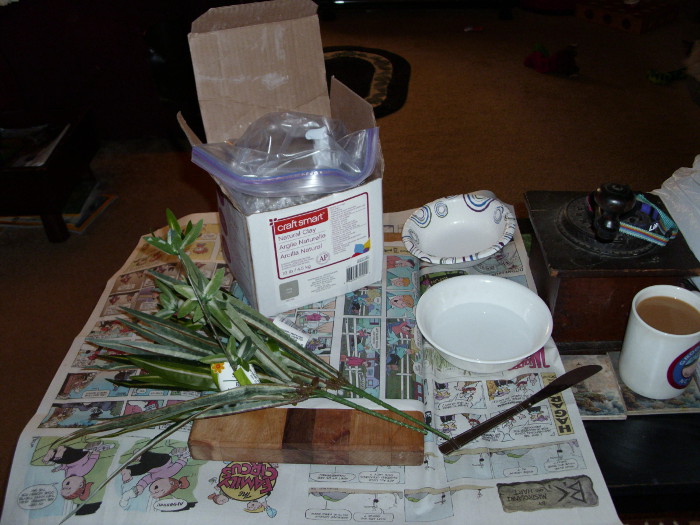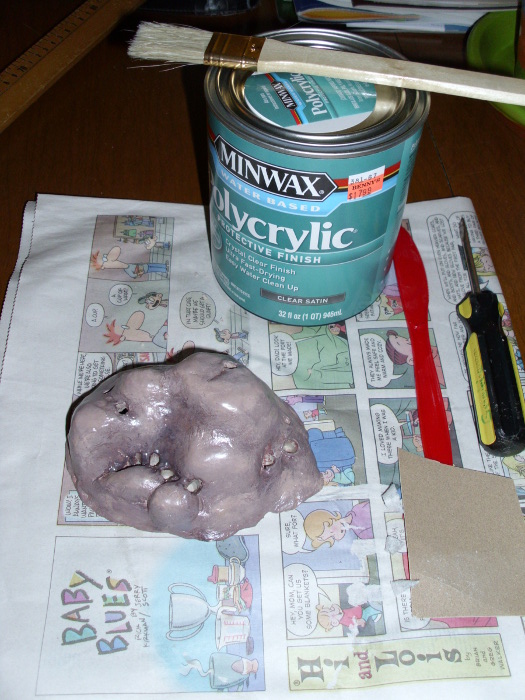indyana
Well-Known Member
- Messages
- 2,336
- Location
- Massachusetts, United States
Here's a little tutorial for making a cage plant arrangement. This isn't really cost effective if you only need one plant, but the more you make, the more money you'll end up saving. Doing it yourself, you also can fit the base to specific floor spaces and use cool plants you find.
Materials
Process
Clean off any stray hot glue threads, wipe down, and voila, it's done!


And the tutorial wouldn't be complete without Amore's look of, "...what is this green witchcraft?!" I don't think he's ever seen a plant in his life, fake or otherwise.

Let me know if you have any questions. I can't wait to try another one of these! In hindsight, a reference picture or two could have made this more realistic, but I'm still quite happy with it.
Materials
- Clay
I used air-dry natural clay, but this could be adapted to any sort of clay that can be hardened and is non toxic. - Tools to work clay
At the very least, a dull knife and some sort of pick to widen out holes in the clay will make it easier. I also used a rolling pin to get the bottom an even thickness. - Water
- Paint
Any sort of non-toxic paint that will work on the dried clay. I used non-toxic acrylics. - Paint brushes
- Sealant
Again, anything non toxic. I used Minwax Polycrylic Clear Satin finish. - Extra fine sand paper (220)
With the sealant I used, the directions recommended lightly sanding between coats to ensure the next coat adhered properly. You could also use this to sand rough spots on your dried clay base before painting. - Fake plant(s)
Dig these up at your local dollar or hobby store, anything you think looks cool. I also washed mine to be certain the dye wouldn't run. Check to make certain things can't fall off and be eaten by your lizard. - Cutting implements
Scissors are useful for cutting apart and trimming pieces to the proper size for your enclosure. Depending what sort of fake plants you buy, you might also need some wire cutters. - Glue
I used a glue gun, but other adhesives or something like silicone aquarium sealant would probably work.
Process
- Set up a work area. I recommend lining it with newspaper or some other protection, as working with clay gets pretty messy. I have my clay, a few utensils to help me work with it, a bowl of water to wet my hands and use to create clay slip for joining pieces (clay + water = slip), and a bowl to mix the slip in. I also have my fake plants out. Also, coffee (optional).

- Roll or pat yourself out a bottom shape the right size for your base. Try to get it to be an even thickness, about 3/8 to 1/2 inch thick.

- Now, start building up your base. You don't want giant, solid chunks of clay. Instead, you want shapes about the same thickness as your bottom. I used little hollowed out domes and balls to build up a boulder-like base. Below is the first dome before I attached it to the bottom.
Technique Note: When joining clay pieces, the process it to score the areas where the two pieces will meet on both pieces (make little shallow criss-cross cuts with a knife or other implement). Then, coat the joining edges with slip, a slippery mix of clay and water. Press the pieces together firmly and wiggle a little to create a solid connection. Then, use your fingers or an implement to smooth together the outer edges to hide the joining line if you so desire. If you want more details, Google "how to join clay pieces".

- I also used the "coil pot" method to build up some areas. Basically, you roll little snakes of the same thickness as the rest of your piece, then stack them up to build walls. You'll want to join them using the same technique above so they hold properly.

- I worked using the above methods and shaping with my hands and a knife until I had the boulder shape I wanted. I used water to smooth areas as necessary.

- I then cut apart my fake plant and stuck the pieces in the way I wanted them. This was to determine where I wanted to bore holes in the structure.

- I then pulled out the plant parts and dug out holes where the stems had been. Because air-dry clay shrinks as it dries, I needed to widen out the holes so they wouldn't be too small once the base hardened. I used a little shellfish pick to scoop out the holes. Be careful you don't push down through the bottom of your base!

- Because I used air-dry clay, I had to wait several days for it to harden all the way. Whatever clay you use, be sure it is complete hard before you proceed.
I also took this as an opportunity to wash and dry the fake plant parts. - Time to paint! I didn't go really wild with my base. I just painted it a natural beige color and added some shadows and highlights with a smaller brush using a stippling technique.

- After the paint was completely dry, I added two coats of sealant. Following the directions for the brand I used, I coated the top, waiting about an hour before turning to paint the bottom, the waited a couple more hours for it to set. I then sanded lightly with extra fine sand paper and put on a second coat in the same fashion. I then let it cure for a day. You'll have to adjust to whatever sealant you use. Just be sure not to plug up your holes.

- Now, time to glue in your plant pieces. I trimmed the pieces to the right height for my enclosure and trimmed the base of pieces so they fit well into the holes. I got an arrangement I liked for each hole before moving on to gluing. For the hot glue, I figured out what pieces were going in the hole, took them out, put a dab of glue into the hole and quickly shoved them back in. I then added additional dots of glue around the hole opening to seal it up.
The way I did it, the glue didn't really show, so I did not bother to go back and paint/seal the glue. My leopard gecko cage isn't very humid, so I wasn't worried too much about waterproofing either.

Clean off any stray hot glue threads, wipe down, and voila, it's done!


And the tutorial wouldn't be complete without Amore's look of, "...what is this green witchcraft?!" I don't think he's ever seen a plant in his life, fake or otherwise.

Let me know if you have any questions. I can't wait to try another one of these! In hindsight, a reference picture or two could have made this more realistic, but I'm still quite happy with it.
